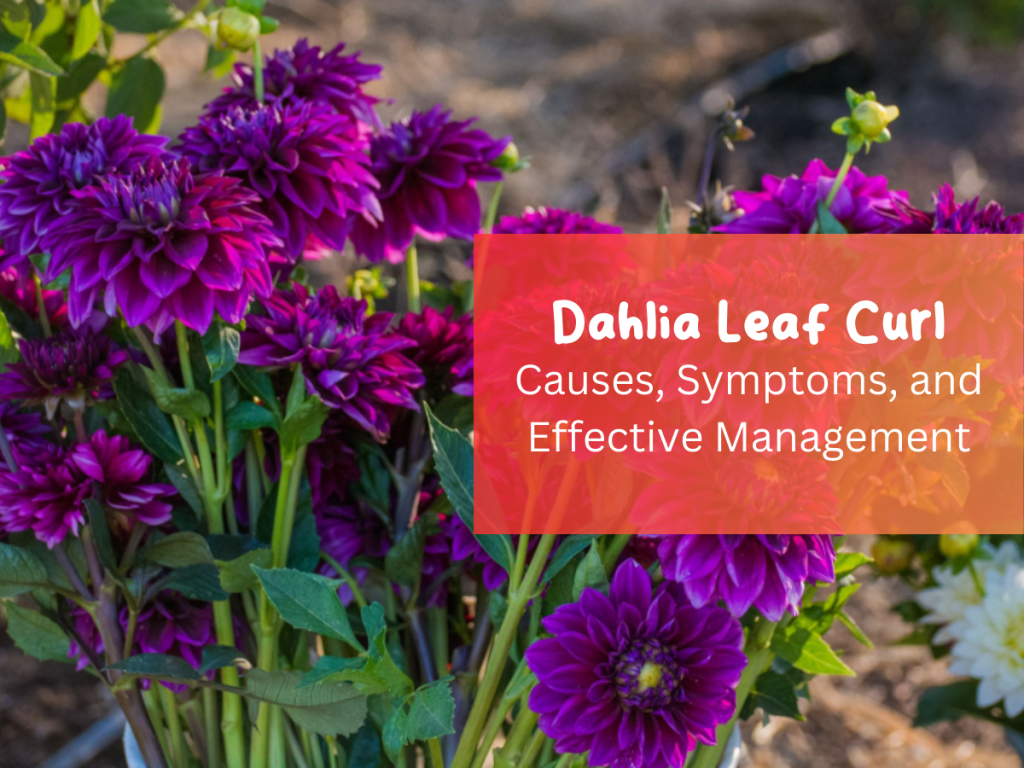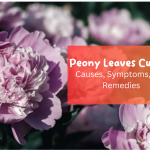Dahlias are beautiful flowering plants well-liked by gardeners for their colorful and varied blossoms. However, dahlias are susceptible to various diseases and disorders like other plant species. Dahlia leaf curl is a prevalent issue that gardeners may encounter. This article will explore the causes, symptoms, and effective management strategies for Dahlia leaf curl.
Understanding the Dahlia Leaf Curl
Dahlia leaf curl is a physiological disorder affecting dahlia plant foliage. It manifests as aberrant curling, twisting, or distortion of the foliage, which results in an unattractive appearance. Although it does not pose a significant hazard to the plant’s overall health, severe cases of dahlia leaf curl can reduce the plant’s vitality.

What causes Dahlia Leaf Curl?
Several factors can contribute to dahlia leaf curl development. Understanding these causes is necessary for efficient management. Let’s examine the primary offenders:
- Environmental Factors: Temperature fluctuations, especially cool nights and warm days, can trigger leaf curl in dahlias. Excessive heat, strong winds, and prolonged sun exposure may contribute to the disorder. Protecting dahlias from extreme weather conditions by shading them on sweltering days or erecting windbreaks can prevent leaf curls.
- Watering Methods: Inconsistent or improper watering can contribute to leaf curl in dahlia plants. Underwatering can cause dehydration and nutrient deficiency while overwatering can suffocate the roots and cause them to decompose. It is essential to rinse dahlias frequently and thoroughly while ensuring the soil is well-drained. Mulching can aid in soil moisture retention and water uptake regulation.
- Nutrient Imbalance: Nutritional deficiencies or imbalances, such as a lack of magnesium or nitrogen, can contribute to leaf curling in dahlias. Magnesium deficiency is frequently linked to interveinal chlorosis (yellowing between leaf veins), which can lead to leaf curling. Conduct a soil test to determine any nutrient deficiencies or imbalances, and then adjust the fertilization regimen accordingly. Healthy growth can be promoted by providing balanced sustenance through organic matter or foliar sprays.
- Pest and Disease Infestation: Certain pests and diseases can weaken the dahlia plant, making it more susceptible to leaf curl. Aphids and spider mites are prevalent pests that can cause damage to and curl the foliage. Infections with viruses, such as the Dahlia mosaic virus, can also cause leaf curling. Regularly inspect your dahlias for signs of pests or diseases and apply pest control measures, such as insecticidal detergents or organic pesticides.
- Genetic Factors: Some dahlia varieties may be more prone to leaf curl than others due to inherent genetic traits. It may be due to their genetic susceptibility if you consistently observe leaf curl in particular cultivars. Consider selecting dahlia varieties with a reputation for leaf curl resistance.
- Overfertilization: Excessive fertilization, especially with high-nitrogen fertilizers, can upset the plant’s nutrient balance and cause leaf curl. It is crucial to adhere to proper fertilization guidelines and refrain from overfeeding your dahlias. Choose slow-release or organic fertilizers that offer a balanced blend of nutrients.
- Chemical Harm: Dahlias can develop leaf curls if exposed to certain chemicals, such as herbicides or pesticides. To prevent accidental plant damage, use caution when administering chemicals near your plants and follow the directions precisely. Avoid spraying chemicals on days with excessive wind or high temperatures.
Root Issues: Problems with the dahlia plant’s root system, such as poor drainage, root rot, or damage from pests, can indirectly contribute to leaf curl. Ensure that your dahlias are planted in well-drained soil to prevent root decay caused by waterlogging. Examine the roots frequently for indications of damage or pest infestation.
Symptoms
Identification of the symptoms of dahlia leaf curl is essential for timely intervention. Here are the most common warning signs:
- Curling and Twisting: The leaves may exhibit upward or downward curling, twisting, or distortion. Typically, this curling is most evident at the leaf margins. The degree of curling can vary, with some leaves exhibiting minor curling and others exhibiting significant twisting.
- Discoloration: Affected leaves may exhibit bleaching or browning. Depending on the severity of the condition, the discoloration’s intensity may vary. In some instances, leaf discoloration may be restricted to specific areas.
- Stunted Growth: In addition to leaf curl, dahlia plants with leaf curl may experience reduced growth and vigor. The plant may be smaller than healthy specimens, with shortened stems and smaller flowers.

Effective Management
Consider the following measures to successfully manage dahlia leaf curl and restore the health of your plants:
- Modifications to the environment: shield dahlias from harsh weather by providing shade on sweltering days and erecting windbreaks. Keeping temperatures stable and averting sudden fluctuations can help prevent leaf curls. Consider protecting your plants with row covers or shade cloth when necessary.
- Proper Watering Methods: Water dahlias frequently and intensely, ensuring the soil drains well. Both overwatering and underwatering can cause plant stress. Mulching can also aid in soil moisture retention and temperature regulation. Monitor the soil’s moisture content and adjust the frequency of irrigation accordingly.
- Management of Nutrients: Examine the soil for nutrient deficiencies or imbalances. Adjust the fertilizer regimen accordingly to provide plants with balanced nutrition. To enhance the nutrient content and structure of the soil, incorporate organic matter such as compost or well-rotted manure. Consider supplementing specific deficiencies with foliar applications containing micronutrients.
- Pest and Disease Control: Regularly inspect your dahlias for signs of pests or diseases. Implement effective pest control measures, such as insecticidal detergents or organic pesticides, to prevent plant-weakening infestations. To prevent the spread of diseases, remove and eliminate all infected plant matter. Encourage insects, such as ladybugs and lacewings, that can aid in the natural control of nuisance populations.
- Pruning and Sanitation: To prevent the spread of the disease, remove and dispose of any infected or severely curled leaves. Additionally, proper sanitation practices, such as cleaning gardening implements, can prevent the spread of disease. Pruning the plants selectively will improve air circulation and reduce congestion, which can foster disease development.
- Variety Selection: Consider selecting dahlia varieties known for their resistance to leaf curl. Consult local nurseries or knowledgeable cultivators to identify cultivars that are less susceptible to this disease.
Conclusion
Although unseemly, dahlia leaf curl can be effectively managed with the right strategies and care. By understanding the causes, recognizing the symptoms, and employing the appropriate management techniques, gardeners can ensure that their dahlias continue flourishing and producing beautiful blooms. Remember to provide adequate nutrition and maintain vigilance against vermin and diseases. With these practices, you can have robust, vibrant dahlias in your garden throughout the growing season. Read article about Peony Leaves Curling: Causes, Symptoms, And Remedies and Monstera Esqueleto: Unveiling The Rare Beauty Of This Unique Plant in Avi Hoffman Garden.







